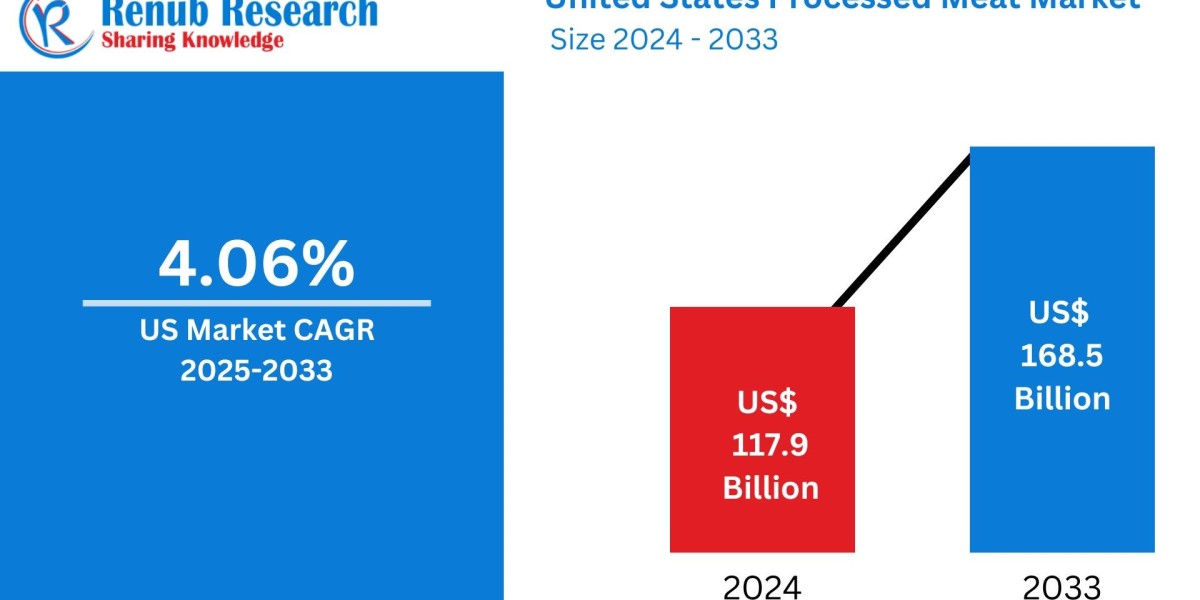United States Processed Meat Market Size and Share Analysis – Forecast 2025 to 2033
Market Overview
The United States Processed Meat Market is anticipated to grow from US$ 117.9 billion in 2024 to US$ 168.5 billion by 2033, expanding at a CAGR of 4.05% during 2025–2033. This robust growth is fueled by shifting consumer lifestyles, increasing demand for convenience foods, and technological advancements in meat processing. Processed meat’s long shelf life, flavor diversity, and versatility have made it a staple across households, quick service restaurants, and institutional catering.
Market Definition
Processed meat includes any meat preserved through salting, smoking, curing, fermentation, or chemical additives. Popular examples include bacon, sausages, hot dogs, deli slices, pepperoni, and jerky. It enhances taste, durability, and utility, making it ideal for the fast-paced American lifestyle.
Key Market Trends
1. Clean Label and Health-Oriented Innovations
Health-conscious consumers are demanding "clean-label" products, leading to increased launches of low-fat, low-sodium, and no-preservative meat items. Claims like “no MSG,” “organic,” “grass-fed,” and “free of artificial additives” are becoming significant purchase influencers.
2. Diversification and Product Innovation
Meat manufacturers are diversifying their portfolios with ethnic flavors, gourmet meats, and functional proteins. Products catering to keto, paleo, and high-protein diets are expanding market reach among wellness-focused consumers.
3. Regional Beef Production Dynamics
The U.S. continues to dominate beef production, particularly in Texas, Missouri, Oklahoma, and Ohio. In 2022, U.S. beef output rose to 28.4 billion pounds, further fueling raw material availability for processed meat production.
Growth Drivers
1. Rising Demand for Convenience Foods
With Americans leading increasingly busy lives, ready-to-eat and ready-to-cook meat options such as frozen patties, deli meats, and sausages are in high demand. The frozen segment is growing due to its longer shelf life and minimal preparation time.
2. Surge in Disposable Income
As disposable income rises, so does consumer willingness to invest in premium meat products like organic, gourmet, and artisanal sausages. This trend is further reinforced by increasing awareness about food quality, sourcing, and sustainability.
3. Expanding Foodservice Sector
The rapid growth of quick service restaurants (QSRs), cafés, and delivery platforms is propelling the use of processed meats in wraps, sandwiches, burgers, and breakfast menus. Processed meats are preferred for their consistency, easy storage, and scalable cooking processes.
4. Technological Investments & Strategic Acquisitions
Companies like Cargill Inc. are acquiring facilities to boost production capacity. In 2024, Cargill acquired two plants from Ahold Delhaize USA to enhance its supply of supermarket-ready beef and pork products in the Northeast.
Related Report
North America Processed Meat Market
South Korea Processed Meat Market
United Kingdom Processed Meat Market
Market Challenges
1. Rising Raw Material & Operating Costs
Volatile prices of livestock feed, packaging materials, and logistics are squeezing margins. The cost of sourcing and processing premium-quality meat has increased, affecting end-product pricing and profitability.
2. Growing Popularity of Plant-Based Alternatives
The emergence of plant-based meat alternatives like soy-, pea-, and mushroom-based products presents a serious challenge. These products appeal to vegetarians, vegans, and flexitarians who are concerned about processed meat’s health risks and environmental footprint.
3. Regulatory Scrutiny and Consumer Awareness
Increasing awareness about links between processed meat and health issues like heart disease and cancer, along with stringent FDA and USDA regulations, are compelling manufacturers to reformulate products or shift toward natural preservatives.
Segment Analysis
By Meat Type
- Beef: Leading segment due to its widespread use in burgers, deli meats, and sausages. The strong beef infrastructure in the U.S. supports its continued dominance.
- Poultry: Gaining popularity for being leaner and lower in fat.
- Pork: Common in bacon and sausages, especially in the breakfast segment.
- Others: Includes lamb, turkey, and specialty meats.
By Processing Type
- Chilled: Preferred for freshness and minimal processing. It is increasingly favored by health-conscious consumers.
- Frozen: Popular for longer shelf life and ease of bulk storage.
- Canned: Convenience and long-term storage appeal to emergency preparedness markets.
By Distribution Channel
- Hypermarkets and Supermarkets: Dominant due to wide assortment, bulk discounts, and visibility.
- Convenience Stores: Drive impulse buying and cater to quick grab-and-go consumers.
- Online Retail: Witnessing rapid growth due to the rise in e-grocery and same-day delivery services.
- Others: Includes specialty stores and direct-to-consumer (DTC) models.
Key Players & Competitive Landscape
The U.S. processed meat market is highly consolidated, with major players focusing on mergers, acquisitions, and innovation to stay competitive.
Major Companies Covered
- Hormel Foods
- Tyson Foods
- Conagra Brands Inc.
- General Mills
- Kraft Heinz Company
- Cargill, Incorporated
- Pilgrim’s Pride Corp.
These companies are investing in automation, sustainability initiatives, and clean-label processing to meet evolving consumer preferences.
Strategic Insights & Future Outlook
- Beef's prominence in American diets and its adaptability in processed forms will likely sustain its dominance.
- Chilled segment is expected to grow fastest, benefiting from the freshness trend.
- Retail transformation, particularly through e-commerce and direct-to-consumer sales, will redefine distribution strategies.
- Innovation in packaging, such as vacuum-sealed, resealable pouches and sustainable materials, will gain traction.
- Hybrid products, such as meat blended with vegetables or plant protein, may emerge as a middle ground solution.
United States Processed Meat Market – Segmentation Overview
By Meat Type
- Poultry
- Beef
- Pork
- Others
By Processed Type
- Frozen
- Chilled
- Canned
By Distribution Channel
- Hypermarkets and Supermarkets
- Convenience Stores
- Online Retail Stores
- Others
Report Scope & Customization
Report Features | Details |
Base Year | 2024 |
Forecast Period | 2025–2033 |
Market Size | US$ Billion |
Segments Covered | Meat Type, Processed Type, Distribution Channel |
Companies Profiled | 7 Key Players |
Customization Scope | 20% Free |
Analyst Support | 1 Year Post-Sale |
Delivery Format | PDF, Excel, PPT/Word on Request |
Key Questions Answered
- What is the expected size of the U.S. processed meat market by 2033?
- Which meat type will lead in market share and why?
- What role does the food service industry play in driving sales?
- How are consumer preferences shaping product innovation?
- Who are the major players and what are their strategic initiatives?
- What impact does the rise in plant-based meat have on traditional players?
Need More Assistance? Our analysts are available to provide detailed insights, assist with customization requests, and help you stay ahead in the competitive landscape.
? Call Us:
USA: +1-678-302-0700
India: +91-120-421-9822
? Email: info@renub.com








